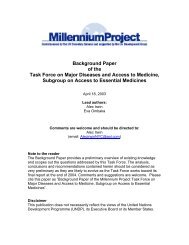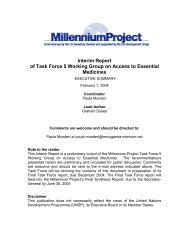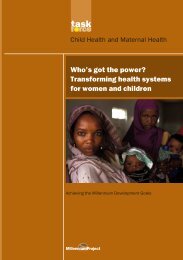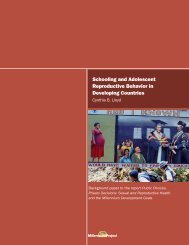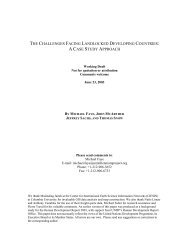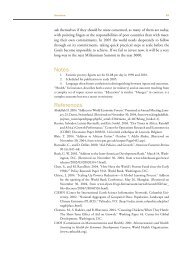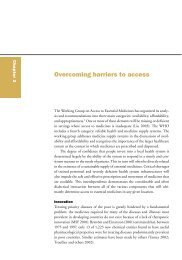Investing in Development A Practical Plan to Achieve the Millennium ...
Investing in Development A Practical Plan to Achieve the Millennium ...
Investing in Development A Practical Plan to Achieve the Millennium ...
You also want an ePaper? Increase the reach of your titles
YUMPU automatically turns print PDFs into web optimized ePapers that Google loves.
Notes<br />
305<br />
Chapter 4<br />
1. It should also <strong>in</strong>clude gender expertise, which is <strong>to</strong>o frequently dropped <strong>in</strong> realtime<br />
activities.<br />
Chapter 5<br />
1. Essential health services related <strong>to</strong> <strong>the</strong> Goals <strong>in</strong>clude preventive and curative health,<br />
reproductive health, environmental health, and nutrition.<br />
2. These <strong>in</strong>terventions cannot work <strong>in</strong> isolation: <strong>the</strong>y need <strong>to</strong> be accompanied by<br />
appropriate policy reforms. These <strong>in</strong>clude <strong>in</strong>creased allocations of <strong>the</strong> national budget <strong>to</strong><br />
agriculture, l<strong>in</strong>k<strong>in</strong>g nutrition with agriculture food security and <strong>the</strong> right <strong>to</strong> adequate food<br />
and fund<strong>in</strong>g it appropriately, empower<strong>in</strong>g women with property rights <strong>to</strong> local resources,<br />
streng<strong>the</strong>n<strong>in</strong>g agricultural research, and remov<strong>in</strong>g <strong>in</strong>ternal and regional barriers <strong>to</strong> trade <strong>in</strong><br />
agricultural <strong>in</strong>puts and products (UN <strong>Millennium</strong> Project 2005d).<br />
3. See for example, World Energy Council, UN DESA, and UNDP (2000). Energy<br />
services for <strong>the</strong> Goals are discussed <strong>in</strong> more detail <strong>in</strong> a forthcom<strong>in</strong>g UN <strong>Millennium</strong> Project<br />
background paper by Vijay Modi (2004).<br />
4. From a public health perspective, it is important <strong>to</strong> reduce recourse <strong>to</strong> abortion by<br />
promot<strong>in</strong>g family plann<strong>in</strong>g services and levels of unsafe abortion by review<strong>in</strong>g <strong>the</strong> laws<br />
regulat<strong>in</strong>g abortion <strong>to</strong> ensure that <strong>the</strong>y address risks <strong>to</strong> health as well as cultural values and<br />
diversity and <strong>in</strong>stitutional capacity.<br />
5. Social protection consists of health <strong>in</strong>surance, disability through work, unemployment<br />
<strong>in</strong>surance, child ma<strong>in</strong>tenance, social security, and old-age pensions.<br />
Chapter 6<br />
1. Tools for <strong>the</strong> job are also an important part of capacity and <strong>in</strong>clude consumables or<br />
commodities required for service delivery. These are part and parcel of <strong>the</strong> recommendations<br />
<strong>in</strong> chapter 5 and <strong>in</strong> <strong>the</strong> task force reports. Here we focus on <strong>the</strong> first three components<br />
of capacity.<br />
2. See, for example, <strong>the</strong> case studies and <strong>in</strong>ternational study of <strong>the</strong> PARIS21 Task<br />
Team on Improved Statistical Support for Moni<strong>to</strong>r<strong>in</strong>g <strong>Development</strong> Goals, available at<br />
www.paris21.org.<br />
3. De<strong>in</strong><strong>in</strong>ger and Mpuga (2004) conclude: “We f<strong>in</strong>d that <strong>the</strong> policy change [abolition<br />
of user fees] improved access and reduced <strong>the</strong> probability of sickness <strong>in</strong> a way that was<br />
particularly beneficial <strong>to</strong> <strong>the</strong> poor. Although <strong>the</strong> challenge of ma<strong>in</strong>ta<strong>in</strong><strong>in</strong>g service quality<br />
rema<strong>in</strong>s, aggregate benefits are estimated <strong>to</strong> be significantly larger than <strong>the</strong> estimated<br />
shortfalls from <strong>the</strong> abolition of user fees.”<br />
Chapter 7<br />
1. Many researchers have advanced this po<strong>in</strong>t, with important early evidence presented<br />
by Knack and Keefer (1995), Mauro (1995), and Sachs and Warner (1995).<br />
2. A number of recent studies have analyzed <strong>the</strong> relationship between governance and<br />
<strong>in</strong>come <strong>in</strong> detail. For example, Radelet (2004) constructs an adjusted governance <strong>in</strong>dica<strong>to</strong>r<br />
controll<strong>in</strong>g for levels of <strong>in</strong>come. It shows that many low-<strong>in</strong>come countries perform very<br />
well on governance relative <strong>to</strong> <strong>the</strong>ir level of <strong>in</strong>come.<br />
3. Glaeser and o<strong>the</strong>rs (2004) also make this po<strong>in</strong>t.<br />
4. See, for example, “The Right of Everyone <strong>to</strong> <strong>the</strong> Highest Atta<strong>in</strong>able Standard of<br />
Physical and Mental Health” (UN 2004d).





